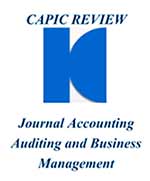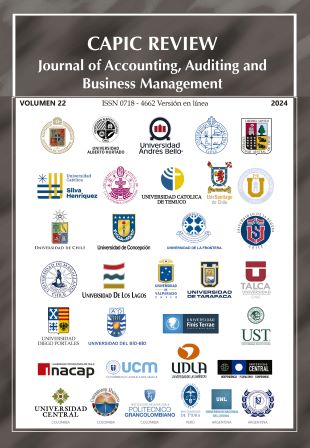The effect of IFRS 16 on financial indicators of profitability and indebtedness
Published 2024-05-27
Keywords
- indebtedness,
- EBITDA margin,
- MILA,
- IFRS 16,
- debt ratio
- profitability ...More
How to Cite
Copyright (c) 2024 Wilvelder Alejandro Varona-Calle, George Luis Calle-Zegarra, María Jesús Farfán-Manrique

This work is licensed under a Creative Commons Attribution-NonCommercial-ShareAlike 4.0 International License.
Abstract
Businessmen evaluate the performance of their business management decision making using financial indicators. These indicators may have variations due to regulatory changes. The International Accounting Standards Board changed the accounting treatment of leases by issuing IFRS 16, which has been applied since 2019.
This study was conducted on retail, construction, real estate and mining companies listed in the Latin American Integrated Market (MILA), with the objective of evaluating the effect of IFRS 16 on the financial indicators of profitability and indebtedness.
To carry out this evaluation, the content of the financial statements for the year 2022, which are published in the official websites of the financial market supervisory entities of each MILA country, was analyzed. In total, information from fifty-nine companies was used to evaluate the relationship between the effect of IFRS 16 on profitability and indebtedness using a correlation test.
The results show that there is a direct proportional relationship between the effect of IFRS 16 application on profitability and indebtedness. This study expands the literature on the effects of IFRS 16 on financial indicators.
Downloads
References
- Alcalde, A., Fávero, L. P. L., y Takamatsu, R. T. (2013). Ebitda margin in Brazilian companies variance decomposition and hierarchical effects. Contaduría y administración, 58(2), 197-220. https://doi.org/10.1016/S0186-1042(13)71215-4
- Arhinful, R. y Radmehr, M. (2023). The effect of financial leverage on financial performance: evidence from non-financial institutions listed on the Tokyo stock market. Journal of Capital Markets Studies, Vol. 7 No. 1, pp. 53-71. https://doi.org/10.1108/JCMS-10-2022-0038
- Barral, A.; Cordobés, M. y Ramírez, J. N. (2014). Los arrendamientos operativos: Impacto de su reconocimiento en los estados financieros y en la política de financiación de las compañías españolas y del Reino Unido. Revista de Contabilidad, 17(2), 212-223. https://doi.org/10.1016/j.rcsar.2014.08.001
- Barros, V., Guedes, M. J., Santos, J., y Sarmento, J. M. (2023). Shareholder activism and firms’ performance. Research in International Business and Finance, 64, 101860. https://doi.org/10.1016/j.ribaf.2022.101860
- Beckman, J. K. y Jervis, K. (2009). The FASB-IASB lease accounting project: implications for the construction industry. Construction Accounting and Taxation, 19(2), 30-35.
- Card, D. (noviembre, 2021). Design‐Based Research in Empirical Microeconomics [Nobel Memorial Lecture]. Estocolmo, Suecia. https://davidcard.berkeley.edu/papers/CardNobelLecture.pdf
- Card, D. y Giuliano, L. (2016). Universal screening increases the representation of low-income and minority students in gifted education. Proceedings of the National Academy of Sciences of the United States of America, 113 (48) 13678-13683. https://doi.org/10.1073/pnas.1605043113.
- Conexión ESAN. (11 julio de 2019). ¿Qué es el arrendamiento de empresa y cuáles son sus beneficios? https://www.esan.edu.pe/conexion-esan/que-es-el-arrendamiento-de-empresa-y-cuales-son-sus-beneficios
- Corporate Finance Institute. (10 de mayo de 2023a). EBITDA Margin. https://corporatefinanceinstitute.com/resources/valuation/ebitda-margin/
- Corporate Finance Institute. (10 de mayo de 2023b). Leverage Ratios. https://corporatefinanceinstitute.com/resources/accounting/leverage-ratios/
- Currie,J., Mueller-Smith, M. y Rossin-Slater, M. (2022). Violence While in Utero: The Impact of Assaults during Pregnancy on Birth Outcomes. The Review of Economics and Statistics; 104 (3): 525–540. doi: https://doi.org/10.1162/rest_a_00965
- Daruwala, Z. (2023). Influence of Financial Leverage on Corporate Profitability: Does it Really Matter? International Journal of Economics and Financial Issues, 13(4), 37–46. https://doi.org/10.32479/ijefi.14461
- Ernst & Young. (22 de enero de2020). Guía de negocios e inversiones de la alianza del pacífico 2018/2019. https://www.ey.com/es_pe/entrepreneurship/guia-de-la-alianza-del-pacifico-2018-2019#:~:text=Considerada%20como%20unidad%20econ%C3%B3mica%2C%20la,Am%C3%A9rica%20Latina%20y%20el%20Caribe
- Goodacre, A. (2003). Operating lease finance in the UK retail sector. The International Review of Retail, Distribution and Consumer Research, 13(1), 99-125. https://doi.org/10.1080/095939603200006537
- Garcilazo, G. J. (2020). NIIF 16: Impacto en estados contables e indicadores financieros de empresas argentinas. (Trabajo final de Grado, Universidad Siglo 21). Repositorio Académico de la Universidad Argentina Siglo 21 https://repositorio.uesiglo21.edu.ar/bitstream/handle/ues21/18693/GARCILAZO_Guillermo_cuartaentrega%20-%20Guillermo.pdf?sequence=1&isAllowed=y
- Imhoff, E.A., Lipe, R.C., & Wright, D.W. (1991). Operating leases: impact of constructive capitalization. Accounting Horizons, 5(1), 51-63.
- International Accounting Standards Board. (2016). Arrendamientos (NIIF 16). https://www.ifrs.org/issued-standards/list-of-standards/ifrs-16-leases/
- International Accounting Standards Board. (2020). Covid-19-Related Rent Concessions.https://www.ifrs.org/content/dam/ifrs/project/ifrs-16-covid-19/covid-19-related-rent-concessions-amendment-to-ifrs-16.pdf
- International Accounting Standards Board. (2021). Covid-19-Related Rent Concessions beyond 30 June 2021. https://www.ifrs.org/content/dam/ifrs/publications/amendments/english/2021/covid-19-related-rent-concessions-beyond-30-june-2021-amendments-to-ifrs-16-unaccompanied.pdf
- IFRS Foundation. (January 2016). Effects Analysis IFRS 16 Leases. https://www.ifrs.org/content/dam/ifrs/project/leases/ifrs/published-documents/ifrs16-effects-analysis.pdf
- Ma, M. y Wayne, T. (2023). Economic consequences of operating lease recognition. Journal of Accounting and Economics, 75(2-3), 101566. https://doi.org/10.1016/j.jacceco.2022.101566
- Matsoma, N. L. (2022). The Nexus between Financial Leverage and Profitability: Evidence From Top-40 Johannesburg Security Exchange (JSE) Listed Companies. Acta Universitatis Danubius. Œconomica, 18(5). Retrieved from https://dj.univ-danubius.ro/index.php/AUDOE/article/view/1932
- Morales-Díaz, J y Zamora-Ramírez, C. (2018). The Impact of IFRS 16 on Key Financial Ratios: A New Methodological Approach. Accounting in Europe, 15(1), 105-133. https://doi.org/10.1080/17449480.2018.1433307
- Mulford, C. W. y Gram, M. (2007). The Effects of Lease Capitalization on Various Financial Measures: An Analysis of the retail Industry. Journal of Applied Research in Accounting and Finance, 2(2), 3-13. https://papers.ssrn.com/abstract=1090463
- Núñez, I.E. (2021). Análisis del impacto en la aplicación de la NIIIF 16 en empresas peruanas y chilenas. [Tesis para optar al grado de Magíster en contabilidad, Universidad de Chile]. Repositorio Académico de la Universidad de Chile http://repositorio.uchile.cl/handle/2250/179337
- Nuryani, N., Heng, T. T., y Juliesta, N. (2015). Capitalization of Operating Lease and Its Impact on Firm's Financial Ratios. Procedia-Social and Behavioral Sciences, 211, 268-276. https://doi.org/10.1016/j.sbspro.2015.11.034
- Pardo, F. y Giner, B. (2018). The capitalization of operating leases: Analysis of the impact on the IBEX 35 companies. Intangible Capital, 14(3), 445-483. https://doi.org/10.3926/ic.1168
- Pearson, K. (1900). X. On the criterion that a given system of deviations from the probable in the case of a correlated system of variables is such that it can be reasonably supposed to have arisen from random sampling. The London, Edinburgh, and Dublin Philosophical Magazine and Journal of Science, 50(302), 157-175.
- Price Waterhouse Coopers. (octubre 2018). NIIF 16 Arrendamientos ¿Esta su empresa preparada? https://www.pwc.com/ve/es/publicaciones/assets/PublicacionesNew/Boletines/Alerta_Tecnica_NIIF16_Arrendamientos_Oct2018.pdf
- Spearman, C. (1904). 'General intelligence,' objectively determined and measured. The American Journal of Psychology, 15(2), 201–293. https://doi.org/10.2307/1412107
- Shapiro, S y Wilk, M (1965). An Analysis of Variance Test for Normality (Complete Samples).
- Biometrika, Vol. 52, No. 3/4, 591-611. https://doi.org/10.2307/2333709
- Ulloa, A (2017). Temas de diálogo y acción regional: Minería en los países de la Alianza del Pacífico (Nota técnica BID n°1383). Banco Interamericano de Desarrollo. http://dx.doi.org/10.18235/0001007
- Vadillo Conesa, C. (2019). NIIF 16 Arrendamientos. Un estudio de su posible impacto y de la información divulgada sobre el mismo [Tesis de maestría, Universitat Politécnica de Valencia]. http://hdl.handle.net/10251/114919
- Valera Moreno, R. & Tresierra Tanaka A. (2017). Finanzas Operativas. Universidad de Piura.



































